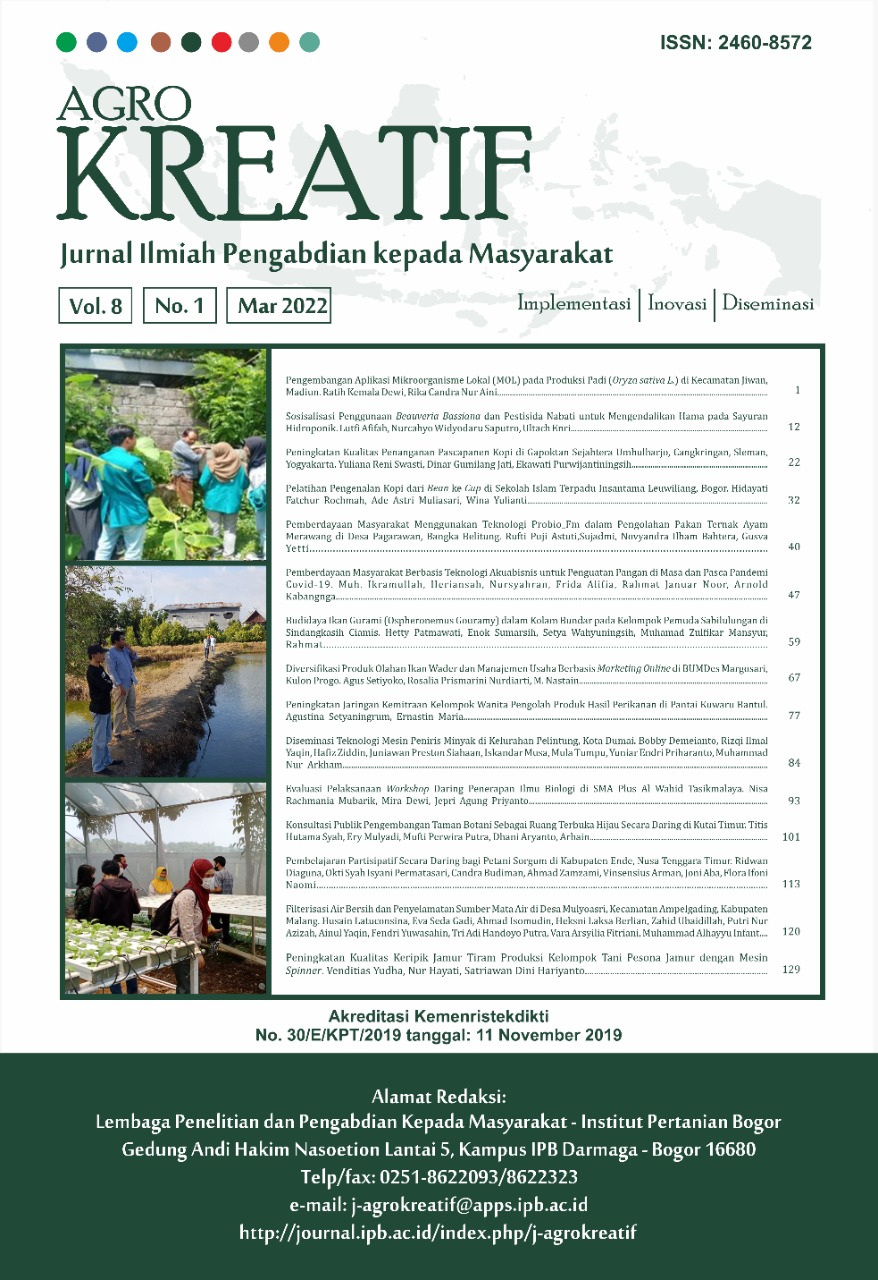Pengembangan Aplikasi Mikroorganisme Lokal (MOL) pada Produksi Padi (Oryza sativa L.) di Kecamatan Jiwan, Madiun
Abstract
Excessive use of inorganic fertilizers has led to land degradation. There need efforts to increase land fertility to increase rice production. One way that can be done is utilizing local microorganisms (MOL) to improve the soil quality. Therefore, productivity can be increased. Community development activities were aimed to socialize the use of MOL in increasing rice production. Community development activities were carried out on January 20-April 20, 2020, at the Dadi Rukun farmer group association (Gapoktan), Sukolilo Village, Jiwan District, Madiun, East Java. The method used is to make a demonstration plot (demplot) of rice production using MOL in the residents' rice fields about 3000 m2. The demplot was given with three kinds of treatment, they were organic fertilizer 200 kg ha-1 with MOL application, 50% an-organic fertilizer (75 kg ha-1 NPK dan 75 kg ha-1 urea) with MOL application, and 100% an-organic fertilizer (150 kg ha-1 NPK dan 150 kg ha-1 urea) without MOL application. Each treatment was repeated 3 times. Apart from using the demplot, socialization activities were also carried out by holding meetings between farmers and field extension workers, practitioners from academia and students who carry out fieldwork practices (PKL) in the village. Feedback in the form of farmer responses is given before and after the end of the activity as evaluation material for the success of the program. The experimental results showed that there was no significant difference in the rice production variables in the three treatments. MOL can be used as an alternative to liquid organic fertilizer to support rice production. Community empowerment activities carried out greatly affect changes in knowledge, perspectives, and skills of farmers in making and utilizing MOL to support rice production so that assistance efforts must continue to be improved.
Downloads
References
Abdullah BS, Tjokrowidjojo, Sularjo. 2008. Perkembangan dan prospek perakitan padi tipe baru di Indonesia. Jurnal Litbang Pertanian. 27(1): 1‒9.
Batara LN, Anas I, Santosa DA, Lestari Y. 2016. Aplikasi mikroorganisme lokal (MOL) diperkaya mikrob berguna pada budi daya padi system of rice intensification (SRI) organik. Jurnal Tanah dan Iklim. 40 (1): 71‒78.
Effendi BH. 2004. Pupuk dan pemupukan. [Skripsi]. Medan (ID): Universitas Sumatera Utara.
Fageria NK. 2014. Mineral Nutrition of Rice. New York (NY): CRC Press. https://doi.org/10.1201/b15392
Manullang RR, Rusmini, Daryono. 2017. Kombinasi mikroorganisme lokal sebagai bioaktivator kompos. Jurnal Hutan Tropis. 5(3): 259‒266. https://doi.org/10.20527/jht.v5i3.4793
Mirwandono E, Sitepu M, Wahyuni TH, Hasnudi, Ginting N, Siregar GAW, Sembiring I. 2018. Nutrition quality test of fermented waste vegetables by bioactivator local microorganisms (MOL) and effective microorganism (EM4). IOP Conference Series: Earth and Environmental. 122: 1‒7. https://doi.org/10.1088/1755-1315/122/1/012127
Pane E, Marwazi M. 2020. Trials of local microorganism composition (MOL) toward growth and production plant lettuce (Lactuca sativa). Budapest International Research in Exact Sciences (BirEx) Journal. 2(1): 44‒51. https://doi.org/10.33258/birex.v2i1.703
Purwasasmita M, Kunia K. 2009. Mikroorganisme lokal sebagai pemicu siklus kehidupan dalam bioreaktor tanaman. Dalam: Prosiding Seminar Nasional Teknik Kimia Indonesia-SNTKI 2009. Bandung (ID): 19‒20 Oktober 2009.
Rafiuddin, Mollah A, Pratiwi E. 2020. Application of various types of local microorganisms to the growth and production of two rice varieties. IOP Conference Series: Earth and Environmental Science. 575: 012148. https://doi.org/10.1088/1755-1315/575/1/012148
Roeswitawati D, Ningsih YU, Muhidin. 2018. The Effect of Local Microorganism (MOL) Concentration of Banana Hump and Fruit Waste on the Growth and Yield of Broccoli Plants (Brassica oleracea). In: Proceedings of the International Conference on Food, Agriculture and Natural Resources (FANRes 2018). Series: Advances in Engineering Research. 172: 310‒314. https://doi.org/10.2991/fanres-18.2018.62
Sodiq AH, Setiawati MR, Santosa DA, Widayat D. 2019. The potency of bio-organic fertilizer containing local microorganism of Cibodas village, Lembang-West Java. IOP Conference Series: Earth and Environmental Science. 383: 012001. https://doi.org/10.1088/1755-1315/383/1/012001
Suprihatno B, Daradjat AA, Satoto, Baehaki SE, Suprihanto, Setyono A, Indrasari SD, Wardana IP, Sembiring H. 2010. Deskripsi Varietas Padi. Subang (ID): Balai Besar Penelitian Tanaman Padi.
Walida H, Surahman E, Harahap FS, Mahardika WA. 2019. Respons pemberian larutan MOL rebung bambu terhadap pertumbuhan dan produksi cabai merah (Capsicum annum L) jenggo F1. Jurnal Pertanian Tropik. 6(3): 424‒429. https://doi.org/10.32734/jpt.v6i3.3189
Zain L. 2016. Pengaruh Penambahan Mikroorganisme Lokal Hasil Fermentasi Buah Maja Terhadap Kualitas Pupuk Kompos dari Feses Sapi Potong. [Skripsi]. Yogyakarta (ID): Universitas Gadjah Mada
This work is licensed under a Creative Commons Attribution-NonCommercial 4.0 International License.



















